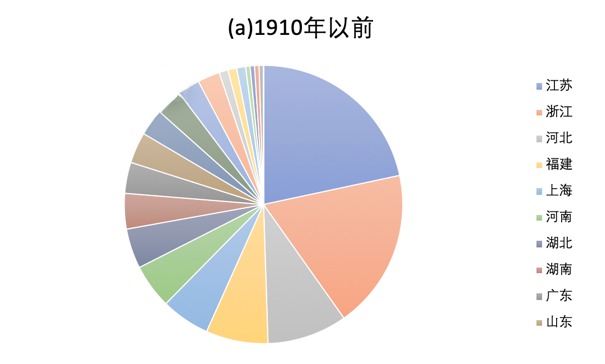 PDF(1230 KB)
PDF(1230 KB)


 PDF(1230 KB)
PDF(1230 KB)
 PDF(1230 KB)
PDF(1230 KB)
基于中国院士群体特征分析的新时代人才合理化建设研究
Research on the Rationalization of Talents in the New Era Based on the Analysis of the Characteristics of Chinese Academicians
 ,
,
 ,
,
 ,
,
 ,
,
 ,
,

[目的/意义] 院士作为推动我国科学技术发展的主力军和精英力量,对其成长规律、履历等的研究对我国人才发现和培养有较大意义。[方法/过程] 采用履历深度分析法,全面收集我国两院院士信息,量化研究院士群体的时空特征、学缘结构特征。[结果/结论] 探究院士群体的基本特征及成才影响因素,并在此基础上提出新时代人才培养的合理化建议。
[Purpose/significance] Academicians are the main and elite force to promote the development of science and technology in China, the research on its growth rule and development history has great significance for the discovery and cultivation of talents in China. [Method/ process] By the CV analysis method, this paper comprehensively collected information on academicians, and carried out the quantitative research on the temporal and spatial characteristics, academic structure characteristics of the academician group. [Result/conclusion] This paper explores the basic characteristics and the factors affecting the achievement of academician group. Then, it puts forward the rationalization suggestions for talent training in the new era.

academician group / temporal and spatial characteristics / academic structure characteristics / growth factors
| [1] |
DENG W, SHAN Y. Analysis on characters and growth factors of academicians of agriculture faculty of chinese academy of engineering[J]. Agricultural science & technology,2015,16(12):2664-2669.
|
| [2] |
毕晋锋. 近代留学的中科院技术科学部院士群体状况分析[J]. 高等财经教育研究, 2004, 7(4):38-41.
|
| [3] |
杨丽, 徐飞. 中国科学院女性院士特征状况计量分析[J]. 科学学研究, 2008, 26(5):942-947.
|
| [4] |
杨琳. 中国高校院士师承效应研究[D]. 广州:中南大学, 2014.
|
| [5] |
耿之雍. 基于CV分析法的中国科学院外籍院士群体状况特征研究[J]. 中国高新科技, 2018, 26(14):100-103.
|
| [6] |
李真真,彭晴晴.中国科学院外籍院士群体特征研究[J].中国科学院院刊,2017,32(3):303-310.
|
| [7] |
徐飞, 陈仕伟. 中国杰出科学家年龄管理策略的新思考——从近十年(2001—2010)中国科学院新增院士与诺贝尔奖获得者年龄比较的反差谈起[J]. 科学学研究, 2012, 30(7):976-982.
|
| [8] |
陶爱民. 中国工程院院士群体状况研究[D].合肥:中国科学技术大学,2009.
|
| [9] |
詹正茂, 舒志彪. 大众传媒对院士科学传播行为的影响分析[J]. 华中科技大学学报(社会科学版), 2008, 22(5):63-67.
|
| [0] |
王静.基于大数据的我国少数民族两院院士成长因素分析[J].长春师范大学学报,2018,37(9):34-39.
|
| [1] |
刘牧, 储祖旺. 新中国培养的两院院士成长因素分析[J]. 理工高教研究, 2006, 25(5):19-22.
|
| [2] |
中国科学院学部.院士名单与简介[EB/OL]. [2019-03-06].http://www.casad.cas.cn/chnl/371/index.html.
|
| [3] |
中国工程院.院士队伍[EB/OL]. [2019-03-06].https://www.cae.cn/cae/html/main/col48/column_48_1.html.
|
| [4] |
刘大卫.履历深度分析法在高管人员甄选中的运用[J].中国人力资源开发.2010(4):22-24.
|
| [5] |
徐飞, 卜晓勇. 中国科学院院士特征状况的计量分析[J]. 自然辩证法研究, 2006, 22(3):68-74.
|
| [6] |
吴殿廷, 李东方, 刘超,等. 高级科技人才成长的环境因素分析——以中国两院院士为例[J]. 自然辩证法研究, 2003, 19(9):54-63.
|
| [17] |
门伟莉,张志强. 科研创造峰值年龄变化规律研究综述[J]. 科学学研究,2013,31(11):1623-1629.
|
| [18] |
王冠中.十年内乱与抗争[M].北京:中共党史出版社,2011.
|
| [19] |
霍宏伟, 肖轶, 赵星宇. 科学领域海外归国与本土高层次人才科研产出比较研究[J]. 中国科技资源导刊, 2015(6):10-17.
|
| [20] |
习近平.习近平:在中国科学院第十九次院士大会、中国工程院第十四次院士大会上的讲话[EB/OL].[2019-01-19].http://www.xinhuanet.com/politics/2018-05/28/c_1122901308.htm.
|
| [21] |
侯秋菊, 杨小宇, 高铭鸿, 等. 我国本土青年科技人才成长态势与影响因素研究[J]. 中国科学院院刊, 2018, 33(3):330-335.
|
武 虹:提出研究思路,撰写论文;
赵立新:设计论文框架;
李砚章:构架模型,撰写论文初稿;
王 昉:获取数据,分析数据,提出论文修改意见;
黄金霞:获取数据,分析数据,提出论文修改意见;
高 洁:资料搜集,提出论文修改意见。
/
| 〈 |
|
〉 |